Professor

tara@se.ritsumei.ac.jp
Optoelectronic Properties and Devices Lab.
Cutting-edge semiconductor electronics for the 21st century
Nitride semiconductors, MBE, LED, power electronics
Researcher's database
The appearance of a new semiconductor known as gallium nitride resulted in blue, green and white light emitting diodes (LED), and the Blu-ray Disc, completely changing our lives. If we can now extract the full potential of this semiconductor we will be able to crate new optical/electronic devices that will solve important problems in the 21st century, which encompass energy, the environment , health and medical care etc. For example we can expect long-life light sources with less power consumption , solar cells of extremely high conversion efficiency, highly-efficient inverters that will support battery car technology, small and strong light sources for sterilization etc. Our laboratory is promoting global cutting-edge research from the fabrication of semiconductor material through to evaluation their properties of and creation devices in order to realize semiconductor electronics that suit the 21st century.
 Molecular beam epitaxy equipment for fabricating semiconductors materials being controlled at the atomic level.
Molecular beam epitaxy equipment for fabricating semiconductors materials being controlled at the atomic level.

imai@se.ritsumei.ac.jp
Electronic device laboratory
Theoretical study on the behavior of single-electron devices
single-electron device, Coulomb blockade,single-electron turnstile, common-gate structure
Researcher's database
Integrated circuits (IC) that perform advanced information processing in PCs are composed of a large number of transistors that are a few dozen nanometers in size and control the transfer of electrical charge-bearing information. Single-electron transistors and other single-electron devices are ultimate devices that can control the motion of individual electrons with the smallest charge by means of their property of repelling each other. Single-electron devices can treat each electron as an information carrier and dramatically improve the degree of integration while reducing the power consumption of ICs. At our laboratory, theoretical research on the behavior of single-electron devices is carried out.
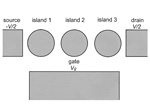
The structure of a triple-dot single-electron device
with single-common-gate.

The stability diagram that represents
the state of electrons within the device.

---
Nanobioelectronics Group
Nanoelectronics and their applications for biosensors.
Nanoelectronics, Bioelectronics, Electrochemistry, Biosensing
Researcher's database
Nanotechnology and biotechnology. These disciplines have advanced independently, and now they are forming a new interdisciplinary research area, namely, nanobiotechnology. We aim to contribute to advances in nanobiotechnology through our expertise in electronics. Our research interests include (a) bio-chemical sensors that electrochemically detect molecules in aqueous solutions or gas, (b) nano-scale CMOS (complementary metal-oxide-semiconductor) devices and integrated circuits for biochemical sensor applications, (c) electrochemical and biochemical energy generation, conversion, and storage.
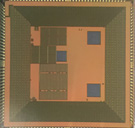 Micrograph of a CMOS LSI chip for biochemical molecular sensing.
Micrograph of a CMOS LSI chip for biochemical molecular sensing.

kakigano@fc.ritsumei.ac.jp
Power System Laboratory
Power electronics for power system applications
Smart Grid, Renewable Energy, DC System
Researcher's database
Power electronics is deeply related to electric power generation, storage, supply, and usage. Therefore, it plays an important role to utilize the electrical energy efficiently. Our laboratory researches power electronics applications in power supply systems for high stability, high quality and high efficiency. The examples of the research subjects are as follows:
1. Study on dc distribution system and its components
2. Study on power converters to make good use of next-generation power devices
3. Study on control for switched reluctance motors
Through those research activities, students enhance deep understanding of power electronics and power system engineering, who will contribute to create future renewable power society.
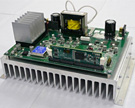 A dc/dc converter for PV module using next-generation power devices (SiC MOSFETs)
A dc/dc converter for PV module using next-generation power devices (SiC MOSFETs)

kawayos@se.ritsumei.ac.jp
Power Electronics Lab (KAWABATA Lab)
Intelligent power electronics
Power Electronics, Intelligent Power Electronics, Clean Power Electronics
Researcher's database
Power electronics are essential in critical quality-of-life technology used in air conditioners, laundry machines, fluorescent lamps etc in addition to various industries, electrical power itself, new energy sources such as solar cells and fuel cells, and battery powered cars and trains. Power electronics concerns technology used to convert and control electric energy and ensure efficient use of it, thus contributing to solving energy and environmental problems, and hence you will be assured of having a worthwhile career after entering the workforce. In more detail we are involved in the following activities. (1) Studying the basis of electronic circuits through fabrication tests of the I/O peripheral circuits of microcomputers and electronic circuits such as drive circuits. (2) Studying the basis of real-time control while creating control software in the C-language in order to control inverters and electric motors using DSP and RISC microcomputers. (3) Studying the basis of control while establishing a system using the famous software of MATLAB and SIMULINK.
 The study of technology that can be utilized in society through research while carrying out experiments by operating the model of a few kW such as with inverters and electric motors using microcomputer control.
The study of technology that can be utilized in society through research while carrying out experiments by operating the model of a few kW such as with inverters and electric motors using microcomputer control.

ykubo@se.ritsumei.ac.jp
Information and Communication System Laboratory
Satellite positioning and applicable technologies
Signal Processing, GPS/GNSS
Researcher's database
The positioning/navigation systems that use artificial satellites is known as GNSS (Global Navigation Satellite System), with the GPS mounted in car navigation systems or cell phones being a representative example. Various applications and ways of processing electrical satellite waves are being considered with regard to the launch and operation of the quasi-zenith satellite system (satellites that reinforce GPS) in Japan and Galileo (European GPS) in Europe etc. This laboratory is concerned with research on a method of improving the accuracy of satellite positioning systems, acceleration, and the positioning algorithm used in the compound positioning system that combines gyro sensors etc. We are also considering upgrading of the information communication system for mobile objects and application in ITS (Intelligent Transport System) in our research.
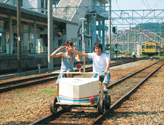 Experimental mobile GPS positioning using a rail line scene (at the Hikone station of the Ohmi Railway)
Experimental mobile GPS positioning using a rail line scene (at the Hikone station of the Ohmi Railway)

ak-sano@fc.ritsumei.ac.jp
Optical Communication Systems Laboratory
Optical fiber communication technology and its application
Optical Communication, Optical Fiber
Researcher's database
Optical fiber communication is a key technology that supports the massive growth of Internet traffic. During the last three decades, transmission capacity per fiber has been increased five orders of magnitude. Our laboratory has been established on April 2017, and we are working on optical fiber communication system technologies and its applications. Our research target covers various aspects of optical communication systems such as long-haul optical transport networks, optical access networks and data-center networks. The transmission performance of long-haul transport networks has dramatically increased by digital coherent transmission scheme. However, the attainable per-fiber capacity is fundamentally limited by fiber nonlinearity, and thus one of main topics in our laboratory is nonlinear compensation techniques to overcome this limitation. We are also focusing on advanced modulation-detection schemes to realize high-speed and low-cost interfaces, and working on optical performance monitoring technique that is indispensable for providing highly-reliable communication services.
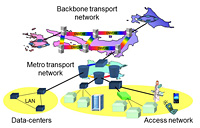 Configuration of optical communication networks
Configuration of optical communication networks

ktakaba@fc.ritsumei.ac.jp
Systems and Control Engineering Laboratory
Modeling, estimation, and control of large-scale networked systems
systems and control engineering, networked control systems
Researcher's database
Dynamical systems arising in various engineering problems in modern society are getting increasingly huge and complex, and exhibit a
large-scale network structure consisting of a number of sub-systems. Examples of such systems are smart grids, sensor networks, formations of mobile vehicles, etc. Mathematical methodologies based on system models are essential to guarantee stability and high-performance of large-scale networked control systems under various constraints. Against this background, we conduct research and education on systems and control engineering aiming at the development of practical and expansible methods for modeling, estimation, and control of large-scale networked systems.Our research interests include robust design of networked control systems, synchronization of sensors or electro-mechanical systems, formation control of mobile vehicles,,etc.
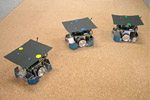 Formation control of a group of mobile robots
Formation control of a group of mobile robots

s-tkym@se.ritsumei.ac.jp
Sensing System Laboratory
Development of measurement systems by autonomous hybrid sensing node network
Sensing network, Telemetry system, Active user interface
Researcher's database
Wireless sensing network systems is the key technology of advanced measurements in various kinds of technical fields. The application system covers measurements in large field area, in dangerous condition, at so far place and by many kinds of multiple parameters. The flexible sensing network system connects heterogeneous sensors to measuring instrument collaboratively, and realizes telemetric control and autonomous operation. Research Activities in Sensing System Laboratory are on (1)Prediction of landslide disaster in mountains and hills, (2)Detection of water disaster by muddy river, (3)Evaluation of physical condition by monitoring of vital signs in dairy life and training and (4)Characteristic field estimation by pedestrian flow at streets and crossroad by distributed cooperative wireless sensing node network system. Additionally, expanding the local network as a telemetry system by using Cloud system, all measurements are managed by host system at remote place. The hybrid sensing network presents so useful platform of measurement and develops various kinds of applications in dynamical measurement.
 Sensing node to monitor landslide at slope of mountain
Sensing node to monitor landslide at slope of mountain

k-taki@fc.ritsumei.ac.jp
Information photonics laboratory
Optical signal processing and its application to optical communication and sensing
Information photonics, Optical signal processing
Researcher's database
The capacity of optical communication is being steadily increased, which brings significant benefits to our lives including broadband services of the Internet. However, the signal processing utilizing electronic circuits causes the limit of processing speed and large power consumption in the optical communication. The information photonics laboratory was just established in April 2012, where we aim at research on optical signal processing based on photonic nanotechnology, and diffraction, interference and non-linear optical effect in optical waveguides and fibers. We pursue technology that can process optical signals directly in the optical domain at high-speed and without increasing power consumption. The lightwave also has a feature that enables us to carry out sensitive detection of biological objects and environmental information without disturbing them. By use of this feature and above-mentioned optical signal processing technology developed for the optical communication, we pursue sensitive metrology for biotechnological, medical and environmental fields, and information photonics for multiplexing or fusion of optical sensors.
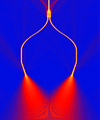 Result obtained with simulation of integrated photonic device
Result obtained with simulation of integrated photonic device

taguchi@se.ritsumei.ac.jp
Biophotonics Lab
High-performance energy exchange devices and energy harvesting devices
Sediment Microbial Fuel Cells, Solar Cells, Metal-Air Batteries, Renewable Energy.
Researcher's database
Nowadays, energy and environmental crisis have become a severe problem. Sustainable energy resources are believed to become an effective solution for this issue. We are developing high-performance energy exchange and energy harvesting devices with a focus on sustainable materials and methods. Our group is working on various projects, such as biofuel cells (BFCs) and dye-sensitized solar cells (DSSCs). BFCs are electrochemical systems that utilize bacteria to convert chemical energy directly to electricity. Its operation principle is based on sustainable biological processes. We are developing some exciting BFCs, such as floating type, soil-based type, and hybrid type. Also, DSSCs, which can convert sunlight directly to electricity, are actively developed. We focus on improving high-quality photoanode and counter electrode by synthesizing novel but low-cost materials. Quasi-solid and solid DSSCs are also investigated to improve its practicality. With accumulated knowledge and inventions in the fields, our lab is collaborating with companies to promote the introduction of research results to the market.
 Paper-based microbial fuel cell, SEM images of the biofilm anodes
Paper-based microbial fuel cell, SEM images of the biofilm anodes

numai@se.ritsumei.ac.jp
Optical and Quantum Electronics Laboratory
Application of interactions of light and electrons to engineering
Opto-Electronics, Quantum Electronics
Researcher's database
Photonics/Quantum-Electronics is a research field that deals with interactions of electromagnetic waves and materials. The aim of our research is to create new devices and systems by controlling the interactions of light and electrons. Our major research themes are nano-scale process technology, semiconductor lasers, imaging devices, and optical fiber communication systems.In the research of the nano-scale process technology, we have developed room-temperature imprint lithography that allows us to copy fine patterns, which were formed on a mold, to a surface of resin on a substrate, at room temperature. In the research of the semiconductor lasers, we have proposed and theoretically analyzed a new ridge structure, which can emit a laser beam with the fundamental transverse mode up to a high light-output. In the research of the imaging devices, we have discovered a structure, which can control the peak wavelength and spectral width independently. In the research of the optical fiber communication systems, we have proposed and analyzed several schemes to reduce four-wave-mixing noises, which are caused by the third-order optical nonlinear effect in the optical fibers.
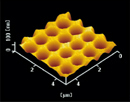 Fabricated pattern by room-temperature imprint lithography
Fabricated pattern by room-temperature imprint lithography

nosaka@fc.ritsumei.ac.jp
Wave Engineering Laboratory
Innovative analog circuit architecture in the 6G era
Analog Circuit, Mixed Signal, Integrated Circuit, Wireless Communication, Terahertz Wave
Researcher's database
Waves include electromagnetic waves such as radio waves and light, sound waves, and gravitational waves. There are millimeter waves and terahertz waves in the boundary area between radio waves and light, and their use in smartphones and IoT has been considered in recent years. In order to utilize this undeveloped frequency, a new technology "wave engineering" that flexibly controls waves is important. For example, controlling the phase to form a beam in the desired direction or switching to a better wavelength in the propagation environment. In our laboratory, we are researching innovative analog integrated circuits for freely controlling the frequency, phase, and amplitude of waves. Through this research, we aim to realize high-speed wireless communication that can be connected without interruption, and to realize sensing and imaging such as food analysis, lesion analysis, and space exploration. In the 6th generation mobile communication system (6G) era, the area of information communication extends not only on the ground but also in the sky, underwater, and space. We will enrich our lives with circuit technology.
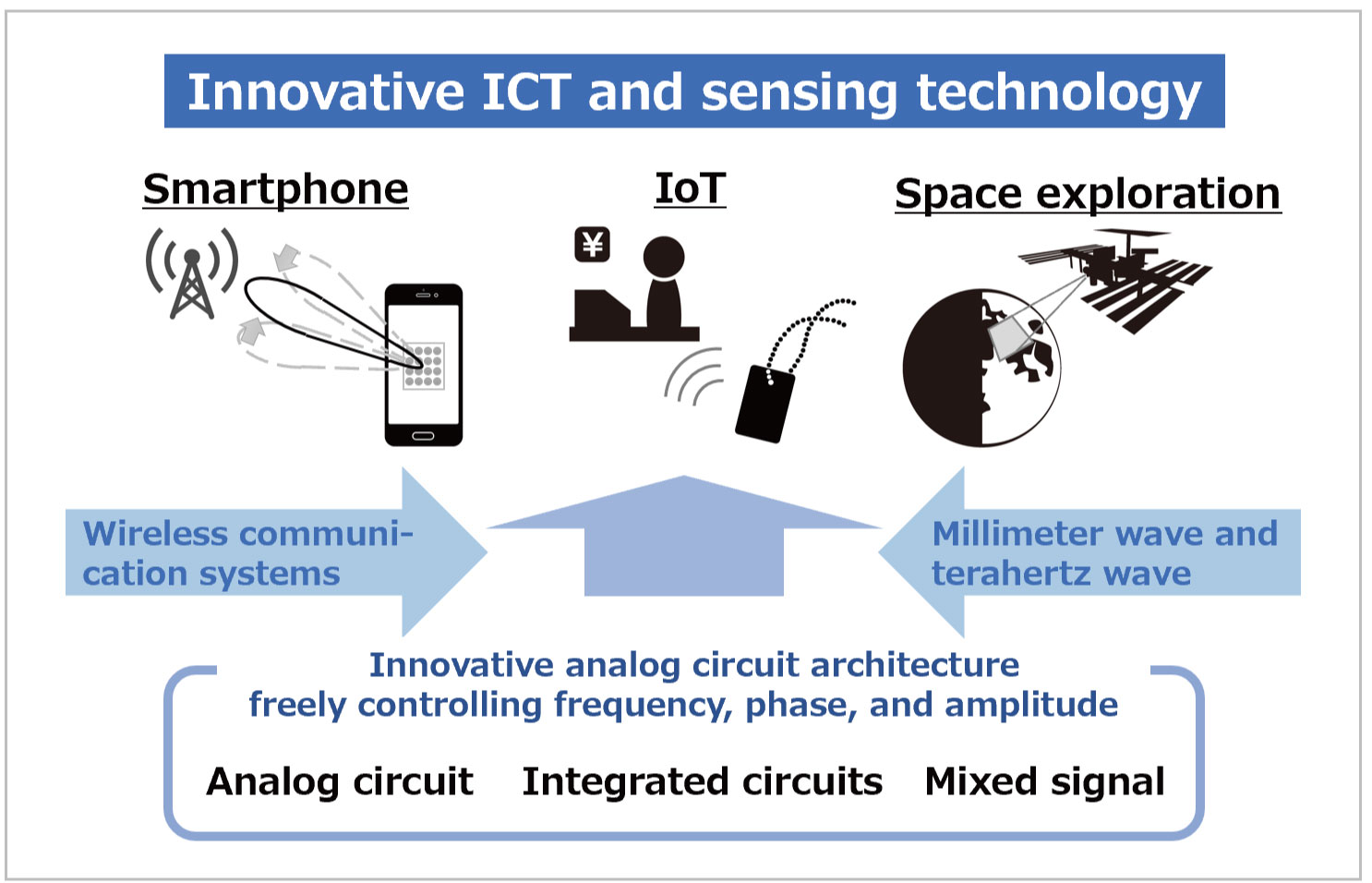 Innovative ICT and sensing technology realized by new analog circuit architecture
Innovative ICT and sensing technology realized by new analog circuit architecture

minemoto@se.ritsumei.ac.jp
Photovoltaic device laboratory Introduction video(YouTube)
High efficiency solar cell and PV system.
Solar cells, Compound semiconductor, Device physics.
Researcher's database Photovoltaics Univ.(YouTube channel)
Energy crisis and environmental pollution is now serious global concern in 21st civilization life. Photovoltaics have gathered much attention as clean energy. Solar cell is semiconductor device which convert sunlight directly to electricity. In our laboratory, we are working on thin-film compound solar cells which have great potential on low-cost fabrication and high energy conversion efficiency. Our research covers broad spectrum of solar cell development, such as theoretical device design (modeling), thin film deposition, crystal growth, and device fabrication. Our main task is "proof-of-concept" for new material and new device structure; especially we are working on chalcogenide material and earth abundant semiconductors. Also, our activity includes flexible and light weight solar cells by new fabrication approach. To realize further popularization of PV, we are working on field test of PV modules and also promoting collaborations with companies and government.

Prototype of flexible
thin-film solar cells

PV system installed
at Techno-Complex

wata-w@fc.ritsumei.ac.jp
Optical information system laboratory
Photonic application for optical information technology and biomedical imaging
biomedical imaging, nanostructured optical device, laser processing
Researcher's database
Light is used in a wide variety of applications including communications, information processing, data storage, energy, healthcare, medicine, and manufacturing. The group engages in fundamental and applied study on photonics, focusing on nanophotonics and nonlinear optics with the aim to harness light. Our research involves optical device fabrication and advanced optical microscopy for minimally invasive medical diagnostics. The group is engaged in interdisciplinary areas of education and research, spanning optics, photonics and electronics.


Fabrication of diffractive optical element by laser processing
Associate Professor

---
Cyber-Physical Systems Laboratory
Analysis, design, and control of cyber-physical systems
Systems and control, networked systems
Researcher's database
Cyber-physical systems (CPSs) are systems in which physical/mechanical devices and information processing and communication are closely connected. We study CPSs from a viewpoint of systems and control engineering. As emerging low-cost devices equip with communication functions, it is now easy to collect various information about systems. This enables us to use such information to operate systems that were once isolated from each other. The amount of information collected and transmitted will continue to increase exponentially in the future. Therefore, it is important to establish technologies to select the necessary information from the vast amount of data. What kind of information is essential to accurately grasp the system's state? What level of accuracy is required to control a system? We are addressing these questions based on systems and control methods.
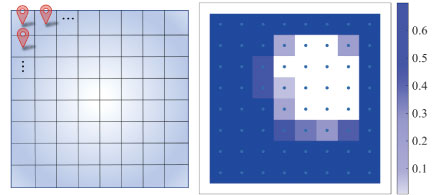 Measuring the gas concentration in a room (left). The right figure shows the importance of measurement spots derived by a mathematical model.
Measuring the gas concentration in a room (left). The right figure shows the importance of measurement spots derived by a mathematical model.

fukumizu@se.ritsumei.ac.jp
Multimedia Infosystems Lab
Machine intelligence for a safe and secure society
Information Systems, Intelligent Signal Processing
Researcher's database
Information processing systems with advanced intelligence technologies such as machine learning, as well as signal processing systems based on multimedia technologies, will contribute to a safe and secure society. In this laboratory, we conduct research on informatics technology that largely utilizes the power of software while still being based on hardware processing. Our research projects include a video processing system for a street- or storefront-mounted surveillance camera that provides a cognitive ability comparable to a human, making it possible to identify suspicious behavior; a non-invasive medical diagnosis system to process the inner body sound signals acquired with high-sensitivity microphones to detect signs of lifestyle diseases such as arteriosclerosis and heart disease in everyday life; and an image quality improvement system that uses computers to sharpen camera images degraded by darkness, backlight, mist, dust, and so on.
 An experimental result of the intelligent camera finding the suspicious individual.
An experimental result of the intelligent camera finding the suspicious individual.

---
Advanced Device Materials Science Laboratory
Multiscale Design of Wide-Bandgap Semiconductors: From Atomic Structure to Device Performance
Diamond Semiconductor, Oxide Semiconductor, Device Reliability, Atomic structure, Power devices.
Researcher's database
Semiconductors have brought about tremendous changes in modern society and have become an indispensable foundation technology for our daily lives. In recent years, research and development of new functions and electronic devices using semiconductors have been advancing toward the realization of a safer and more sustainable society. There is no doubt that semiconductor technology will continue to play a central role in supporting society in the future. In our laboratory, we are aiming to establish highly efficient electrical control technologies with low power loss by focusing on transparent wide bandgap materials such as diamond semiconductors and oxide semiconductors.We are advancing scale-bridging research that spans from nano-scale material analysis focused on atomic structure to macro-scale functional design at the device level.
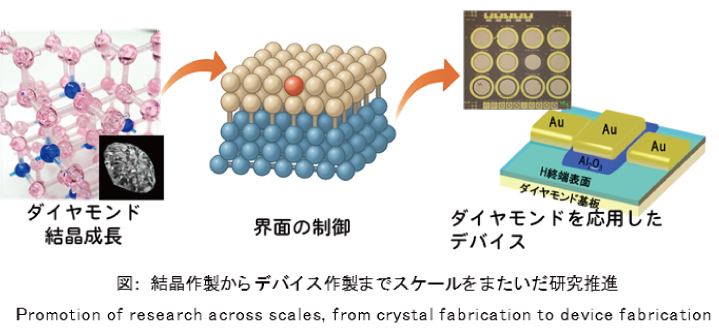 An experimental result of the intelligent camera finding the suspicious individual.
An experimental result of the intelligent camera finding the suspicious individual.

iguchan@fc.ritsumei.ac.jp
Atomically thin semiconductor device Lab.
Optical and electrical Properties of graphene and related atomically thin layered materials and device application, van der Waals epitaxy
Graphene, Atomically thin layered materials, van der Waals hetero structure, valleytronics, exciton physics, phonon physics, thermal properties, moire structure, van der Waals epitaxy, optoelectronic devices
Researcher's database
We study atomically thin layered materials, such like graphene or MoS2, focused as “Ultimately thin materials”. In these layered materials, quantum confinement effects and symmetry breaking emerge unusual properties unlike bulk materials. We challenge to create novel devices towards next generation computing or energy conversion application using these specific features. We also fabricate new quantum structures composed of layered materials using van der Waals epitaxy and elucidate their properties using various microscopes.
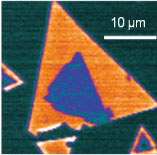 PL image of the layered material MoS2/MoSe2.
PL image of the layered material MoS2/MoSe2.






























 Molecular beam epitaxy equipment for fabricating semiconductors materials being controlled at the atomic level.
Molecular beam epitaxy equipment for fabricating semiconductors materials being controlled at the atomic level.

 Micrograph of a CMOS LSI chip for biochemical molecular sensing.
Micrograph of a CMOS LSI chip for biochemical molecular sensing.
 A dc/dc converter for PV module using next-generation power devices (SiC MOSFETs)
A dc/dc converter for PV module using next-generation power devices (SiC MOSFETs) The study of technology that can be utilized in society through research while carrying out experiments by operating the model of a few kW such as with inverters and electric motors using microcomputer control.
The study of technology that can be utilized in society through research while carrying out experiments by operating the model of a few kW such as with inverters and electric motors using microcomputer control. Experimental mobile GPS positioning using a rail line scene (at the Hikone station of the Ohmi Railway)
Experimental mobile GPS positioning using a rail line scene (at the Hikone station of the Ohmi Railway) Configuration of optical communication networks
Configuration of optical communication networks Formation control of a group of mobile robots
Formation control of a group of mobile robots Sensing node to monitor landslide at slope of mountain
Sensing node to monitor landslide at slope of mountain Result obtained with simulation of integrated photonic device
Result obtained with simulation of integrated photonic device Paper-based microbial fuel cell, SEM images of the biofilm anodes
Paper-based microbial fuel cell, SEM images of the biofilm anodes  Fabricated pattern by room-temperature imprint lithography
Fabricated pattern by room-temperature imprint lithography Innovative ICT and sensing technology realized by new analog circuit architecture
Innovative ICT and sensing technology realized by new analog circuit architecture



 Measuring the gas concentration in a room (left). The right figure shows the importance of measurement spots derived by a mathematical model.
Measuring the gas concentration in a room (left). The right figure shows the importance of measurement spots derived by a mathematical model. An experimental result of the intelligent camera finding the suspicious individual.
An experimental result of the intelligent camera finding the suspicious individual. An experimental result of the intelligent camera finding the suspicious individual.
An experimental result of the intelligent camera finding the suspicious individual. PL image of the layered material MoS2/MoSe2.
PL image of the layered material MoS2/MoSe2.